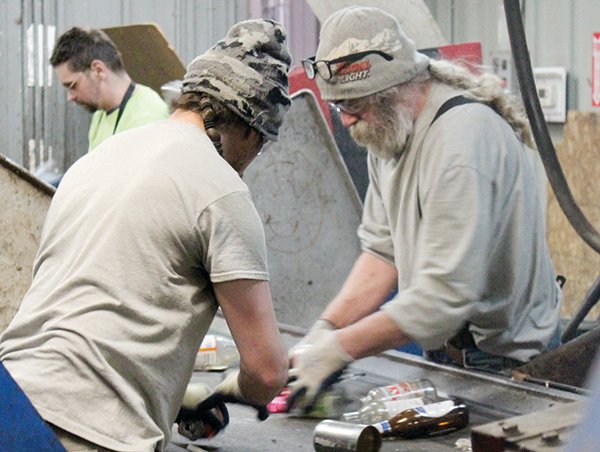Support the Timberjay by making a donation.
China tariffs cut into recycling market prices
County officials say subsidized recycling program cuts landfill costs
REGIONAL— For most residents of St. Louis County, recycling waste is a matter of tossing our cans, bottles, and paper products in a big blue bin— and forgetting about it. Yet behind the scenes, …
This item is available in full to subscribers.
Attention subscribers
To continue reading, you will need to either log in to your subscriber account, or purchase a new subscription.
If you are a current print subscriber, you can set up a free website account and connect your subscription to it by clicking here.
If you are a digital subscriber with an active, online-only subscription then you already have an account here. Just reset your password if you've not yet logged in to your account on this new site.
Otherwise, click here to view your options for subscribing.
Please log in to continue |
China tariffs cut into recycling market prices
County officials say subsidized recycling program cuts landfill costs
REGIONAL— For most residents of St. Louis County, recycling waste is a matter of tossing our cans, bottles, and paper products in a big blue bin— and forgetting about it. Yet behind the scenes, there’s a complex system in place to sort and transport all those materials for reuse by manufacturers in a long list of everyday products.
Those materials are traded in a marketplace that is increasingly influenced by global factors, most recently the decision by China to sharply limit the imports of recycled materials from the United States.
For years, China’s demand for raw materials had seemed limitless, and that helped to maintain prices for the plastics and paper that have poured in daily to the St. Louis County recycling facility near Virginia.
Even when prices were relatively high, St. Louis County has never turned a profit on the county-wide recycling program. Instead, the county spends an average of at least $100,000 a year subsidizing the process.
Last year, the county budgeted $675,000 to contract with Greenforest Recycling Resources, of Brainerd, for collecting and sorting the county’s recycled materials. They actually spent $725,000. Much of the difference is from unfunded state mandates, such as electronics recycling, or from materials that are recycled, but not part of the standard waste stream. According to Program Coordinator Dave Fink, most of that cost is out of the hands of the county.
“The market is like a rollercoaster when it comes to how much the companies can pay,” Fink said. “It’s been at the bottom for a while.”
What’s driving the market for recycling is two-fold.
On one hand, making new material products is actually cheaper than reusing most recycled material. But there is a bigger, silent, hand at play—politics.
While Fink said most of the collected materials in the county stay in the Midwest, Greenforest owner Jeff Grunenwald said the prices the market follow are not set locally.
“China is blocking a lot of material, whether it is quality issues with some companies or just putting on tariffs,” he said. “It causes a backlog that allows mills to name their price.”
And those prices can be really low, and in some cases, even cost prohibitive.
“Category one and two plastics (such as a milk jugs) can reliably get five to six cents per pound,” Program Planner Steve Pellinen said. “The other categories (three through seven, such as yogurt containers) we were lucky if we got a penny per pound.”
The county stopped collecting those plastics because it wasn’t worth the expense.
Prices could rebound slightly if the United States and China found common ground on trade. “There is opportunity to move materials between the countries again,” Grunenwald said, “but it will still be inspected with a lot of scrutiny.”
While the material the county collects fetches little in the marketplace, the cost to transport those materials can be hefty.
“About half of the cost is just hauling the material from the greater county area to a transfer facility,” Pellinen said.
In the past, according to Fink, the county contracted with mining companies to haul the material to the Twin Cities on empty trucks after they made deliveries to local mines.
Despite the costs associated with the county’s recycling effort, Fink said it’s still cheaper than landfilling. “It’s all about landfill abatement,” Fink said. “We just did a cover of 9.5 acres of a sanitary landfill. It cost us $1.3 million to do that. The last landfill cell constructed was in 2012 at 5 acres for $1.5 million. Recycling is a good fit for the environment as a whole. Some year it will pay for itself.”
Currently, the county takes in 52,000 tons of waste annually at the regional landfill. But a significant amount of that could still be recycled. According to Pallinen, just over 12 percent of that trash that ends up landfilled is paper with other potentially recyclable materials making up an additional 10 percent.
In total, about 106,000 tons were collected in waste from households, commercial and industrial applications from everywhere in the county except for Duluth. About 52 percent of that was recycled.
To get the public more involved in recycling, Fink said the county has a number of events each year bringing mobile collection sites to towns around the region.
School children from every district also visit the facility in Virginia and several schools, including North Woods, actually have a collection site on their property.
For more information on the program or to find the closest collection point, call 1-800-450-9278 or visit www.stlouiscountymn.gov/recycle.






